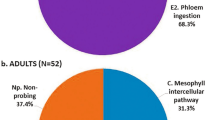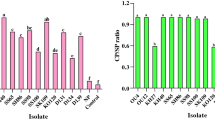Abstract
A DISEASED condition of the citrus red mite, Panonychus citri (McG.), was first observed in material collected dear Oxnard, California, in 1958. Experimental proof that the disease was transmissible was obtained by two methods: first, by transferring healthy mites to lemons bearing a diseased culture, and secondly, by spraying an aqueous suspension, prepared from ground-up diseased mites, on to healthy mite colonies. In each case the healthy mites developed infection1. Many diseased mites become paralysed with the legs stiffened ventrally. Diarrhœa sometimes occurs and mites may be found dead with the anal end fixed to the feeding surface by fæcal material.
Similar content being viewed by others
Article PDF
References
Munger, F., Gilmore, J. E., and Davis, W. S., Calif. Citrograph., 44, (6), 190, 216 (1959).
Williams, R. C., and Smith, K. M., Biochim. Biophys. Acta, 28, 464 (1958).
Smith, K. M., Parasitology, 48, 459 (1958).
Author information
Authors and Affiliations
Rights and permissions
About this article
Cite this article
SMITH, K., HILLS, G., MUNGER, F. et al. A Suspected Virus Disease of the Citrus Red Mite Panonychus citri (McG.). Nature 184, 70 (1959). https://doi.org/10.1038/184070a0
Issue Date:
DOI: https://doi.org/10.1038/184070a0
This article is cited by
-
Transcriptome profiling of a spirodiclofen susceptible and resistant strain of the European red mite Panonychus ulmi using strand-specific RNA-seq
BMC Genomics (2015)
-
Étude de l'action deBacillus thuringiensis chez le scorpionButhus occitanus
Entomophaga (1974)
-
Effect of cultural measures on the population density of the fruit tree red spider mite,Metatetranychus ulmi Koch (Acari, Tetranychidae)
Tijdschrift Over Plantenziekten (1962)
Comments
By submitting a comment you agree to abide by our Terms and Community Guidelines. If you find something abusive or that does not comply with our terms or guidelines please flag it as inappropriate.



